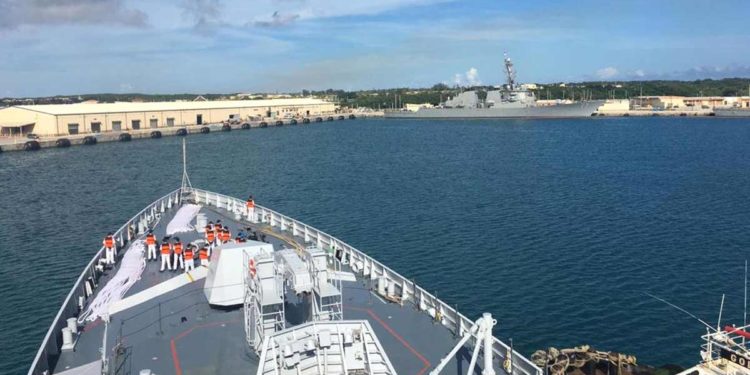Indian Naval Ships (INS) Shivalik and Kadmatt arrived at Guam, an island territory of the USA, on 21 August as part of the ongoing deployment by Eastern Naval Command (ENC) to nations in Southeast Asia and the Pacific Ocean. The two ships are scheduled to participate in the annual Exercise Malabar-21, between navies of Australia, India, Japan and the USA. This series of maritime exercises commenced in 1992 as a bilateral IN-USN exercise and has grown in stature over the years, to include the four prominent navies, in the Pacific and Indian Ocean Region.
As part of the exercise, Vice Admiral Ajendra Bahadur Singh, Flag Officer Commanding-in-Chief, Eastern Naval Command (ENC) will have operational discussions with Rear Admiral Leonard “Butch” Dollaga, Commander CTF-74. These discussions will focus on developing an action plan, and coordinated operations, in the maritime domain. Flag Officer Commanding Eastern Fleet, Rear Admiral Tarun Sobti would embark onboard INS Shivalik during the conduct of the exercise on 26 August.
The participating Indian ships, Shivalik and Kadmatt, are the latest indigenously designed and built, multi-role Guided Missile Stealth Frigate and Anti-Submarine Corvette respectively and form part of the Indian Navy’s Eastern Fleet based at Eastern Naval Command, Visakhapatnam. INS Shivalik is commanded by Captain Kapil Mehta whilst INS Kadmatt is commanded by Commander RK Maharana. The two ships are equipped with a versatile array of weapons and sensors, can carry multi-role helicopters and represent the growth of India’s warship building capabilities.
The exercise Malabar-21 will be conducted with the United States Navy, Japan Maritime Self-Defense Force and the Royal Australian Navy at sea from August 26-29. The exercise will provide an opportunity for common-minded navies to enhance interoperability, gain from best practices and develop a common understanding of procedures for Maritime Security Operations.
Malabar-21 would witness high-tempo exercises conducted between destroyers, frigates, corvettes, submarines, helicopters and long-range maritime patrol aircraft of the participating navies. Complex surface, sub-surface and air operations including live weapon firing drills, anti-surface, anti-air and anti-submarine warfare drills, joint manoeuvres and tactical exercises will be conducted during the exercise. The conduct of these exercises, despite Covid-19 restrictions, is a testimony of synergy between the participating navies and commitment to safer seas.










Discussion about this post